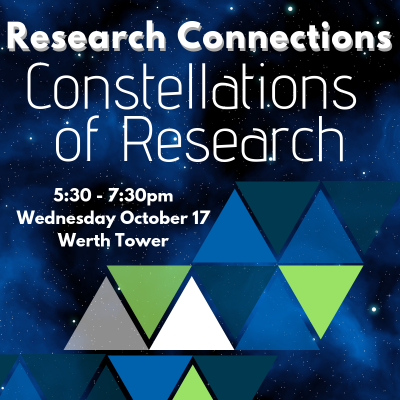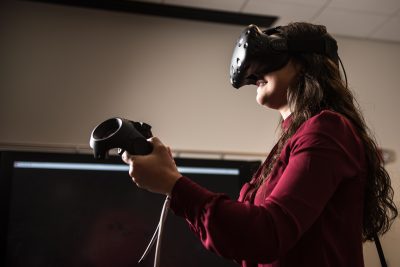 On Friday November 30th OPIM Innovate held their last workshop of the semester on Augmented Reality (AR) presented by adjunct professor Ryan O’Connor. “Augmented Reality is a combination of a real and virtual scene, giving additional information to the real world,” began Professor O’Connor. Augmented Reality is often confused with Virtual Reality (VR), but this distinction of a combination of the real and virtual is what differentiates AR from VR, a program in which the user is completely immersed in a virtual scene. This combination of the real and virtual is very hard to achieve. Developers need to create precise models, analyze locations and optical properties of the viewer and the display, and all devices need to be accurately calibrated so that the AR can look as realistic as possible.
On Friday November 30th OPIM Innovate held their last workshop of the semester on Augmented Reality (AR) presented by adjunct professor Ryan O’Connor. “Augmented Reality is a combination of a real and virtual scene, giving additional information to the real world,” began Professor O’Connor. Augmented Reality is often confused with Virtual Reality (VR), but this distinction of a combination of the real and virtual is what differentiates AR from VR, a program in which the user is completely immersed in a virtual scene. This combination of the real and virtual is very hard to achieve. Developers need to create precise models, analyze locations and optical properties of the viewer and the display, and all devices need to be accurately calibrated so that the AR can look as realistic as possible.
The advancement of cameras is one of the main reasons that AR has become so realistic. The cameras themselves are high quality which pushes the AR to be more accurate. The most popular, and potentially longest standing application of AR, relies on cameras to project a solid yellow line on to TV screens across the country. The NFL has been using AR since 1998 to help viewers at home distinguish the first down line on the field. Other popular uses of AR are Snapchat filters and Pokemon Go. Both of these tools project something animated into the real world in order for an interactive social experience. In addition, big companies like Ikea and Lego have seen the positive impacts AR has had on their businesses. Ikea released a tool that shows people how a piece of furniture would look in your home before you buy it, and in a similar way, Lego invested in a tool that projects a built life size model of the toy being sold so that people know exactly what they are buying.
Aside from all of these fun applications, AR can and has been used for some important tools in the fields of education, medicine, air traffic, and sustainability. In education, AR has been used for dissection, to avoid harming animals, and in geography producing 3D maps for students to analyze terrain. These 3D maps are also used by professionals to analyze sustainability, another field that benefits from AR. Sustainability has been greatly affected by the implications of AR. In 2015 Tesla released an electric car that had the first ever electroluminescent paint job, a carbon dioxide emissions camera, and a projector attached. The paint emits light to reflect an endangered fish, the CO2 camera shows how much pollution is being released into the air, and the projector projects images of animals on to buildings and objects in cities. Tesla is hoping that this car will remind and encourage people to be more environmentally conscious. This mobile projection is often done on a small scale in other vehicles to show things like the speedometer, fuel gauge, and temperature gauge. This technology is something that the Air Force, and even commercial aircrafts, have incorporated into their plans. This way pertinent information can be displayed directly on a window, so the pilot won’t have to take their eyes off of their paths. The implication of the safety feature has been one of the major focuses of the applications of AR. With AR a user can attempt something dangerous without suffering as dangerous repercussions. In the medical field doctors can project AR images as an overlay so that they can practice a procedure before acting on it.
Even with all of these applications and advancements, the technology is still not completely developed. Some tools, such as the measurement tool on the iPhone, are great ideas that still need some work in calibration and development. “The technology is getting there, but still not completely there,” said O’Connor as he demonstrated the app’s shortcomings. Although this app wasn’t as advanced as some of the other examples and demonstrations that O’Connor was able to show the class, he did highlight that Apple, and other products, offer a variety of free AR training tools for those who would be interested.
One attendant who held special interest in Augmented Reality is PJ Barnett, a graduate student working on his PhD with the School of Educational Psychology in the Cognition, Instruction, and Learning Technology (CILT) Program. Barnett’s initial interest in AR came when he was diagnosed dyslexic while completing his masters. “The potential for AR for students like me is huge, because then they’re not dependent on whether they can read or not read, it all becomes visual,” he said. Since then, Barnett has done some research on the technology to learn how he could implement it with his own students. “I think there’s a lot of potential to use AR to teach people and make them more comfortable around things like tools and maker space equipment. If you were watching a video of your tool because you just scanned it with your phone, it makes the process much more immersive.”
This workshop was the last workshop of the semester. Thank you to everyone who attended the workshops and we hope to see you next semester!
 On Wednesday December 12th OPIM Innovate hosted some special guests from South Windsor High School. These guests were students enrolled in Ellen Festi’s class on Entrepreneurship. This course teaches students at the high school how different technologies disrupt businesses and Ms. Festi thought there would be no better way to introduce students to its emerging technologies than at the University of Connecticut’s very own OPIM Innovate.
On Wednesday December 12th OPIM Innovate hosted some special guests from South Windsor High School. These guests were students enrolled in Ellen Festi’s class on Entrepreneurship. This course teaches students at the high school how different technologies disrupt businesses and Ms. Festi thought there would be no better way to introduce students to its emerging technologies than at the University of Connecticut’s very own OPIM Innovate. On Friday November 30th OPIM Innovate held their last workshop of the semester on Augmented Reality (AR) presented by adjunct professor Ryan O’Connor. “Augmented Reality is a combination of a real and virtual scene, giving additional information to the real world,” began Professor O’Connor. Augmented Reality is often confused with Virtual Reality (VR), but this distinction of a combination of the real and virtual is what differentiates AR from VR, a program in which the user is completely immersed in a virtual scene. This combination of the real and virtual is very hard to achieve. Developers need to create precise models, analyze locations and optical properties of the viewer and the display, and all devices need to be accurately calibrated so that the AR can look as realistic as possible.
On Friday November 30th OPIM Innovate held their last workshop of the semester on Augmented Reality (AR) presented by adjunct professor Ryan O’Connor. “Augmented Reality is a combination of a real and virtual scene, giving additional information to the real world,” began Professor O’Connor. Augmented Reality is often confused with Virtual Reality (VR), but this distinction of a combination of the real and virtual is what differentiates AR from VR, a program in which the user is completely immersed in a virtual scene. This combination of the real and virtual is very hard to achieve. Developers need to create precise models, analyze locations and optical properties of the viewer and the display, and all devices need to be accurately calibrated so that the AR can look as realistic as possible. Hannah Bonitz
Hannah Bonitz As a top 25 public research and Research 1 university, the University of Connecticut makes both undergraduate and graduate research a priority. Throughout 2018 the university has invested millions of dollars into student enriching programs, they have contributed over $370 million dollars to the Connecticut economy, and they have received over 600 patents granted from UConn technologies. Perhaps what is most encouraging, is the support students receive from their peers, faculty, and the university across all disciplines. Although health behavior, energy, cybersecurity, and neuroscience are their most popular fields, students from psychology and communication have their own research facilities as well.
As a top 25 public research and Research 1 university, the University of Connecticut makes both undergraduate and graduate research a priority. Throughout 2018 the university has invested millions of dollars into student enriching programs, they have contributed over $370 million dollars to the Connecticut economy, and they have received over 600 patents granted from UConn technologies. Perhaps what is most encouraging, is the support students receive from their peers, faculty, and the university across all disciplines. Although health behavior, energy, cybersecurity, and neuroscience are their most popular fields, students from psychology and communication have their own research facilities as well. This semester OPIM Innovate is hosting open hours for students who are interested in Virtual Reality. On Wednesdays from 9-12 students are welcomed in the Gladstein Lab in the School of Business room 391 to experience the three Virtual Reality options OPIM Innovate has to offer. For beginners, students can experience Google Cardboard, a set of glasses that can fully immerse you in a Virtual Reality experience. For students who may have some experience with VR, the HTC Vive is a more advanced Virtual Reality headset and platform. This headset can transport students into a whole new realm of 3D spaces using sensors and controllers to create hyper-realistic content. For students with advanced Virtual Reality experience, OPIM Innovate has Google Cardboard Camera. Google Cardboard Camera is an app with allows any device to capture and create 3D environments using a phone camera, and they are made visible through Google Cardboard. All three of these options are open to any student who is interested in attending. We hope to see you there!
This semester OPIM Innovate is hosting open hours for students who are interested in Virtual Reality. On Wednesdays from 9-12 students are welcomed in the Gladstein Lab in the School of Business room 391 to experience the three Virtual Reality options OPIM Innovate has to offer. For beginners, students can experience Google Cardboard, a set of glasses that can fully immerse you in a Virtual Reality experience. For students who may have some experience with VR, the HTC Vive is a more advanced Virtual Reality headset and platform. This headset can transport students into a whole new realm of 3D spaces using sensors and controllers to create hyper-realistic content. For students with advanced Virtual Reality experience, OPIM Innovate has Google Cardboard Camera. Google Cardboard Camera is an app with allows any device to capture and create 3D environments using a phone camera, and they are made visible through Google Cardboard. All three of these options are open to any student who is interested in attending. We hope to see you there!